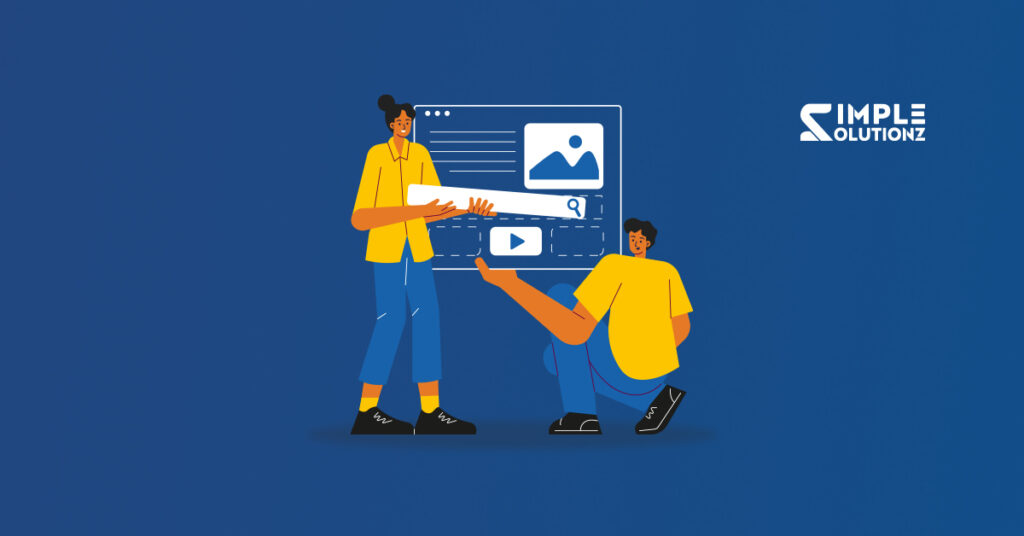Visually appealing with a better functional website makes your online presence strong. A survey shows that about 80% of users believe well-designed websites are necessary for credible business. Are you losing your business due to wicked website design?
Here are five unmistakable signs that show your website needs upgrades. Explore professional website redesign agencies that provide powerful user engagement with strong strategies.
Contents
- What Does the Process of Redesigning a Website Involve?
- Identify Your Website’s Current Performance
- When Do You Need Website Redesign Services?
- The Role of a Website Redesign Agency
- Why Hire a Professional Agency?
- Customized Solutions for Small Businesses
- Case Studies: Realizing Transformation
- Embrace Digital Evolution
- FAQ’S
What Does the Process of Redesigning a Website Involve?
A website redesign involves altering or updating its content, interface, structure, or navigation to enhance its performance or increase visitor conversions. Businesses choose website redesigns for several reasons, including rebranding initiatives or the desire to attract greater traffic and engagement.
Identify Your Website’s Current Performance
Traffic and Engagement Metrics: Understanding Visitor Behavior
Begin your assessment by delving into your website’s traffic metrics. Explore the number of visitors, page views, and the duration of their stay using tools like Google Analytics. A detailed examination of user behavior will reveal high-performance pages and potential areas for improvement.
Conversion Rates and User Journey: Optimizing the Conversion Funnel
Evaluate your website’s conversion rates to gauge its effectiveness in turning visitors into customers or achieving other desired actions. Map out the user journey from landing to conversion, identifying potential friction points or drop-off areas. This analysis lays the groundwork for streamlining the conversion funnel and enhancing user experience.
Design and Aesthetics: Aesthetic Appeal and User Experience
Assess the overall design and aesthetics of your website. Consider whether it aligns with design trends and accurately reflects your brand identity. Evaluate user experience by mastering strategies for brand growth, examining navigation intuitiveness, content readability, and the visual appeal of key elements. An outdated design can contribute to high bounce rates and decreased engagement.
Given the incidence of mobile browsing, ensure your website is fully optimized for various devices. Evaluate the mobile responsiveness of each page, checking for seamless navigation and readability. Addressing any issues related to mobile responsiveness is vital to accommodate the diverse ways users access your site.

When Do You Need Website Redesign Services?
1. High Bounce Rates and Low Conversion Rates
High bounce and low conversion rates are telltale signs that a website may miss the mark when engaging and converting visitors. Beyond being mere metrics, these indicators often signify a deeper issue: potential dissatisfaction with the user experience.
Dive into the world of user behavior analysis and understand the factors contributing to these metrics. How can you balance multiple content distribution goals? Uncover the psychology behind user engagement, emphasizing the importance of intuitive design, compelling content, and seamless navigation.
Explore case studies where websites with high bounce rates transformed into user-friendly havens, improving conversion rates. This section aims to identify the problem and provide actionable insights into redesign strategies to elevate user engagement and boost conversion rates.
2. Outdated Design Trends
The aesthetics of a website play a pivotal role in attracting and retaining visitors. Outdated design trends not only risk aesthetic staleness but also impact functionality. Journey through the ever-evolving world of web design, understanding the cyclical nature of trends and the importance of staying current.
- Dive into the impact of aesthetics on brand perception and user trust.
- Utilize real-world examples to highlight how prominent brands successfully navigated design evolution to stay relevant.
- Illustrate the power of visual storytelling and brand continuity in maintaining a fresh and engaging online presence. It aims to inspire businesses to embrace design evolution as a strategic move, underscoring its impact on user perception and brand loyalty.
3. Mobile Responsiveness Issues
In a time where smartphones and tablets take center stage, mobile responsiveness is no longer a mere feature; it has become an essential requirement. Examine the profound shift towards mobile-first browsing habits and the user’s expectations regarding a seamless cross-device experience.
Delve into the consequences of mobile responsiveness issues, from decreased user satisfaction to diminished search engine rankings.
Provide a comprehensive guide on optimizing websites for mobile responsiveness, incorporating responsive design principles and mobile-friendly technologies. Leverage statistics and case studies to underscore the importance of mobile optimization. This section aims to empower businesses with the knowledge and strategies to ensure their websites thrive in the mobile-first landscape.
4. Slow Page Loading Speed
In the digital age, speed is of the essence. Slow-loading pages can lead to frustrated users and abandoned visits.
Explore the multifaceted impact of page loading speed on user experience, from user satisfaction to search engine ranking penalties.
Dive into the technical aspects of website speed optimization, covering aspects such as image compression, browser caching, and server response times. Illustrate the before-and-after scenarios of websites that underwent speed optimization, highlighting the tangible improvements in user experience. This section aims to equip businesses with actionable strategies to enhance website speed and overall performance.
5. Declining Search Engine Rankings
A drop in search engine rankings can be a red flag for the overall health of a website. Unravel the complexities of Search Engine Optimization, examining the interconnected factors that influence search engine algorithms. Display how a well-executed website redesign can positively impact search engine rankings through improved content structure, keyword optimization, and enhanced user experience.
Provide practical tips on conducting an SEO audit and developing a strategic SEO plan within the framework of a website redesign. Use case studies to highlight instances businesses regained and exceeded their previous search engine positions through strategic SEO-focused redesigns. This section aims to demystify SEO for businesses, emphasizing its critical role in maintaining online visibility.
The Role of a Website Redesign Agency
Transitioning into the professional realm, we will explore the critical role played by website redesign agencies. From conceptualization to execution, these agencies bring expertise and experience. Understand their integrated approach to transforming your digital presence and elevating your brand.
Delve into the intricacies of agency-client collaboration, emphasizing the importance of understanding your business goals, target audience, and unique brand identity. Highlight the role of agencies in conducting thorough market research, competitor analysis, and user testing to inform the redesign strategy. Utilize case studies to highlight successful collaborations, illustrating the transformative power of professional expertise.
Why Hire a Professional Agency?
Delve into many benefits of entrusting your website redesign to a professional agency. Explore the strategic insights, industry knowledge, and execution excellence that professionals bring to the forefront. From the initial consultation to the post-launch phase, examine how professional agencies add value at every stage of the redesign process.
Highlight the role of agencies in staying alongside the newest design trends, technologies, and user behaviors. Utilize testimonials from businesses that experienced significant improvements in their online presence after collaborating with professional agencies. This section gives businesses a compelling case for seeking professional expertise in their website redesign journey.
Customized Solutions for Small Businesses
The importance of tailored redesign solutions is the need of small businesses. Discuss the challenges small businesses face in allocating resources for a redesign and present cost-effective strategies that cater to smaller budgets.
Highlight the role of agencies in providing personalized solutions, considering small businesses’ specific goals, audience, and budget constraints. Utilize case studies of successful redesigns for small enterprises, highlighting how strategic and budget-conscious approaches can significantly improve online presence. This section aims to empower small businesses with the knowledge and confidence to embark on a redesign journey tailored to their unique circumstances
Case Studies: Realizing Transformation
Embark on a journey through case studies that showcase the transformative power of website redesigns. Visualize the impact through before-and-after snapshots, gaining insights into successful projects that have redefined brands and enhanced their online presence.
Explore diverse industries, from e-commerce to service-based businesses, showcasing how strategic redesigns addressed specific challenges and yielded tangible results. Analyze the key elements of each case study, identifying patterns and lessons that can be applied to businesses across different sectors. This section aims to inspire businesses with concrete examples of successful website redesigns, demonstrating the potential for positive transformation.
Embrace Digital Evolution
A website stands as a dynamic representation of your brand. Recognizing the signs that signal a need for redesign is the first step toward mastering the digital realm. Whether you are a large enterprise or a small business, this comprehensive guide is a roadmap, unlocking the strategies and insights necessary for a successful website redesign.
Embrace the opportunities that digital evolution presents, and let your website be a testament to your brand’s resilience and relevance in the dynamic world of the internet. By strategically addressing the signs and leveraging professional expertise, businesses can navigate the complexities of website redesign and emerge with a revitalized digital presence that captivates audiences and achieves tangible business goals.
FAQ’S
1. How Often Should You Redesign Your Website?
The frequency of website redesigning depends on several factors, including
- Industry trends
- Technological advancements
- Evolving user expectations
Consider revisiting your website design every 2 to 3 years. However, more frequent updates may be necessary if your business experiences significant changes, such as rebranding, a shift in target audience, or introducing new products or services.
Regularly assessing your site’s performance and staying attuned to design trends will help determine when a redesign is warranted to maintain a fresh and engaging online presence.
2. What is the Cost of Website Redesign?
The cost of a website redesign varies based on several factors tailored to the specific needs and goals of the project. It is challenging to provide a one-size-fits-all estimate.
Here are key considerations that influence the overall cost:
1. Scope and Complexity
- A larger scope with intricate design and functionality requirements incurs higher expenses.
2. Design Requirements
- The complexity of desired design elements, including custom graphics, multimedia integration, and unique layouts, can contribute to costs.
3. Functionality and Features
- Adding specific functionalities such as e-commerce capabilities, content management systems (CMS), or third-party integrations can influence costs.
4. Responsive Design
- Ensuring your website is mobile-responsive is crucial. Costs may vary depending on whether the redesign involves optimizing an existing site for mobile or creating a responsive design from scratch.
5. SEO Considerations
- If maintaining or improving search engine rankings is a priority, the redesign should incorporate SEO best practices.
6. Technical Requirements
- The underlying technological choices, such as the content management system (CMS) and other technical considerations, can impact costs.
7. Content Development
- Costs may include copywriting, photography, or other content creation services if updating or creating updated content is part of the redesign.
8. Testing and Quality Assurance
- Allocating resources for thorough testing and quality assurance is critical. While this phase contributes to overall costs, it ensures a smooth transition and a polished final product.
9. Timeline
- The project timeline can affect costs. Rushed projects may require additional resources and, consequently, incur higher expenses.
10. Professional Services
- Engaging professional services, such as hiring a web designer, developer, or a full-service agency, contributes to costs.
3. Can You Redesign a Website Without Losing SEO Rankings?
Yes, it is possible to redesign a website without sacrificing SEO rankings, but it requires a strategic and careful approach. When planning a redesign, prioritize the preservation of key SEO elements, such as:
- URLs
- Meta tags
- Content structure
- Implement 301 redirects for any altered URLs to maintain link equity.
- Conduct thorough keyword research to optimize the updated content and ensure essential SEO elements are seamlessly transitioned to the redesigned site.
- Monitoring your website’s performance post-redesign and making necessary adjustments will help preserve and improve SEO rankings.

